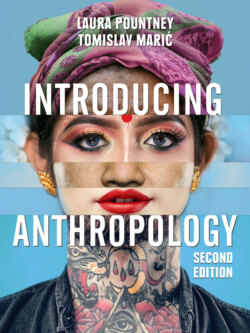Читать книгу Introducing Anthropology - Laura Pountney - Страница 132
Handedness
ОглавлениеRobert Hertz (2008[1909]) suggested that most societies encourage right-handedness through the process of socialization. He begins with the question of why the right hand should be associated almost universally with goodness, purity and auspiciousness, and the left hand with evil, pollution and death. Hertz noticed that biological asymmetry was exaggerated by training, and that most societies encourage right-handedness at the expense of the left. Left-handed children may be discouraged from using their left hand or foot. They may be punished or ridiculed and have their left hand bound or otherwise restricted. In many cultures it is common to eat and to greet someone with the right hand. The left hand may be associated with defecation and symbolize uncleanliness. The values and associations attributed to the right hand differ markedly from those of the left. The body gives societies a cue – left-handedness is everywhere less common than the dominance of the right. It is a convenient marker on which cultures have created symbolic associations that are as nearly universal as any symbol can be. When associations of left and right are compared cross-culturally, Hertz noticed that there is a striking uniformity. He also observed that, among the Maori, the right side is regarded as male and the left side as female and profane. For example, he states:
Among the Maori, the right side is the sacred side, the seat of good and creative powers, the left is the profane side, possessing no virtue other than certain disturbing and suspect powers … the right side is the ‘side of life’ (and of strength) while the left is the ‘side of death’ (and of weakness). Fortunate and life giving influences enter us from the right and through our right side. Inversely, death and misery penetrate to the core of our being from the left. ([1909] 2008: 45)
When asking himself why these polarities exist between left and right, Hertz suggests they derive from an attempt to link the human body to the natural world and to religion. The asymmetry between the right and left hand reflects the fundamental polarity of the spiritual world – that between the sacred and the profane – and this in turn reflects man’s dual nature. ‘It is because man is a double being – a natural/profane being and a social/ sacred being’ ([1909] 2008: 112). With Hertz, the body is no longer seen as a mere biological given, but is shown to carry the imprint of culture. What appears to be natural, the opposition between right and left, is in reality a social fact. Fiona Bowie (2006) suggests that it is the human ability to use the body as a symbol, to think with and to impose meaning on the world that makes handedness so relevant. Therefore, cultural rules can be made to appear natural. The symbolic weight given to right–left polarity is decreasing in Western societies, but this does not mean that categories associated with left- and right-handedness necessarily disappear. They may become attached to new meanings. This may reflect secularization or a reduction in gender role differentiation.
handedness A preference for using one hand as opposed to the other
